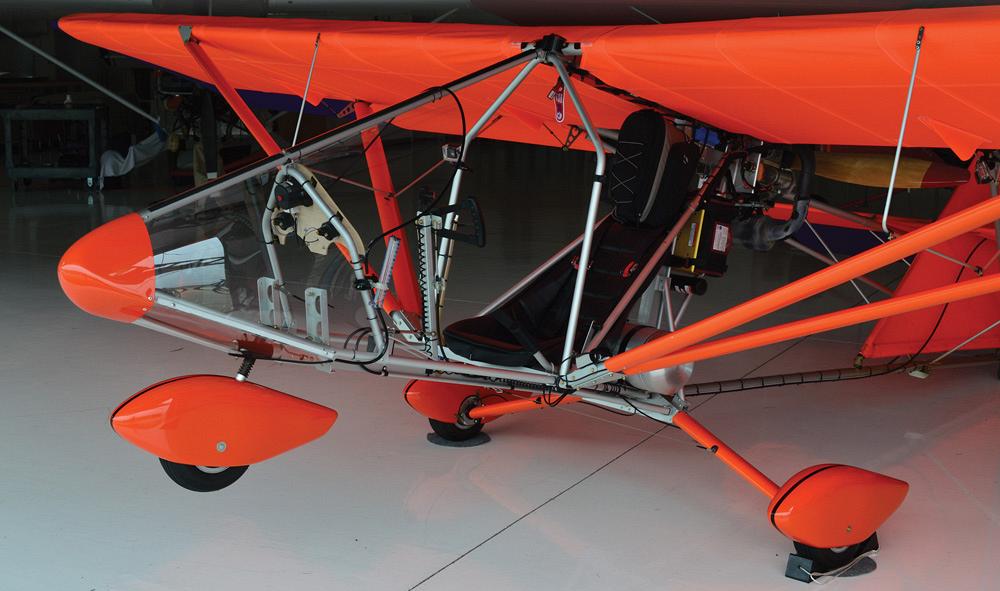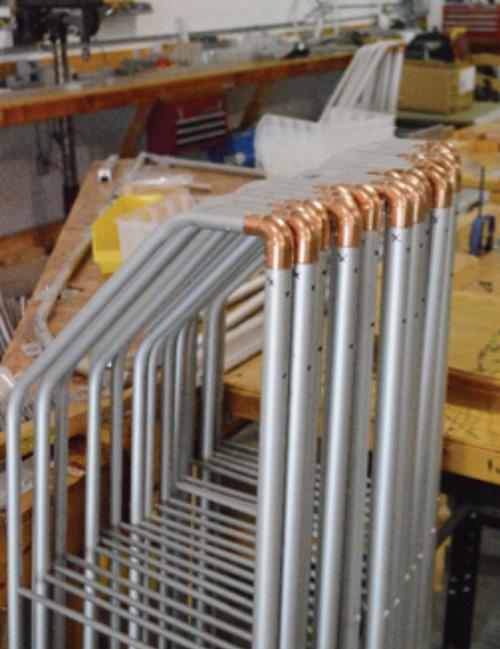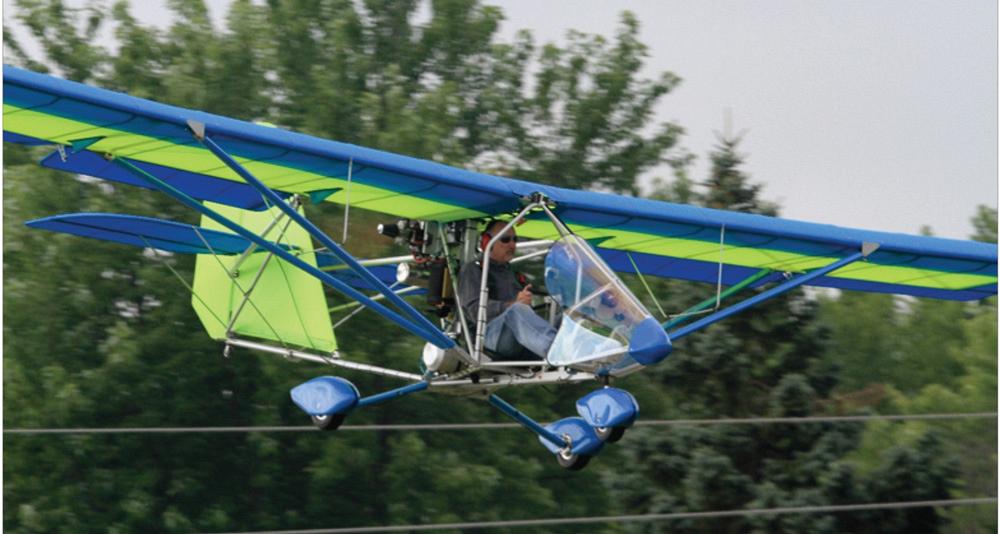- FMA
- The Fabricator
- FABTECH
- Canadian Metalworking
Categories
- Additive Manufacturing
- Aluminum Welding
- Arc Welding
- Assembly and Joining
- Automation and Robotics
- Bending and Forming
- Consumables
- Cutting and Weld Prep
- Electric Vehicles
- En Español
- Finishing
- Hydroforming
- Laser Cutting
- Laser Welding
- Machining
- Manufacturing Software
- Materials Handling
- Metals/Materials
- Oxyfuel Cutting
- Plasma Cutting
- Power Tools
- Punching and Other Holemaking
- Roll Forming
- Safety
- Sawing
- Shearing
- Shop Management
- Testing and Measuring
- Tube and Pipe Fabrication
- Tube and Pipe Production
- Waterjet Cutting
Industry Directory
Webcasts
Podcasts
FAB 40
Advertise
Subscribe
Account Login
Search
Fabricators flying ultralights
Why buy it when you can build it?
- By Eric Lundin
- June 24, 2015
- Article
- Tube and Pipe Fabrication

Simplicity usually is key in developing a functional and eye-pleasing design. Terry Raber kept it simple when he came up with the Aerolite 103 ultralight aircraft. The design has been modified only slightly since its commercial introduction in 1997.
Visit a typical metal fabrication shop and you’re likely to see more ways to shape, cut, and join metals than you can count on two hands: bending, flaring, notching, sawing, gas tungsten arc welding (GTAW), gas metal arc welding (GMAW), and on and on. It’s not just work, but greatly satisfying work, turning raw materials into components or subassemblies that will become a finished product that someone wants or needs: a weight bench, a bicycle, a hospital bed, a handrail, or any of 10,000 other items. In most small shops, the owners, managers and employees are regular guys who love to run machines and get their hands dirty, turning flat sheets of metal or straight lengths of tube into useful products.
Visit an aircraft hangar and you’ll probably hear pilots telling stories about spectacular flights and using abbreviations and opaque terms that beg explanation, terms such as wind shear, stall speed, artificial horizon, VFR (visual flight rules), IFR (instrument flight rules), and the like. These, too, are regular guys, but they make a living or have a hobby that isn’t for the faint of heart. It takes more than a little courage to pilot a vehicle on a lengthy trip that has to fight gravity every mile of the way.
When you visit U-FLY-IT, DeLand, Fla., you're likely to meet people who are both fabricators and pilots. This isn’t a coincidence; it’s part of the company’s business model.
Dreams Take Wing
While everyone is familiar with two- and four-seat private airplanes, the Federal Aviation Administration (FAA) defines several distinct categories of aircraft for general (unscheduled) aviation, commonly considered recreational or hobby flying:
- Gliders and sailplanes (up to two seats, maximum weight of 1,654 lbs. if unpowered, 1,874 lbs. if powered)
- Normal, utility, and acrobatic (up to nine seats, maximum takeoff weight of 12,500 lbs.)
- Primary (up to four seats, maximum takeoff weight of 3,375 lbs.)
- Very light airplanes (up to two seats, single-spark or compression engine, maximum weight 1,654 lbs., landing configuration stall speed no more than 45 knots, VFR)
The growing popularity of hang gliding in the 1970s was considered to be a motivator for interest in a fifth category, Part 103 Ultralight Aircraft, which the FAA authorized in 1982. As the name implies, these are much lighter than other aircraft: 254 lbs. maximum empty weight. They are limited to a pilot and a maximum of one passenger, a maximum fuel capacity of 5 gallons, and a maximum speed of 55 knots (63 MPH) at full throttle in level flight. The power-off stall speed must not exceed 24 knots (28 MPH).
Conspicuously absent is any mention of horsepower. A quick lesson from an aircraft builder tells why.
“Everyone asks how big the engine is and how much horsepower the engine develops, but these aren’t as important as most people think,” said Dennis Carley, U-FLY-IT’s owner. He explained that thrust, the forward force developed by the engine’s crankshaft and the propeller, is actually what designers consider when developing a new aircraft. The other three factors that govern flight are lift, drag, and gravity. The amount of thrust, in combination with the shape and size of the wing, generates lift. So long as the thrust exceeds the aircraft’s air resistance (drag) and the amount of lift overcomes gravity, the aircraft will get off the ground. The discussion has to include all four factors. An aerodynamically sloppy design, a wing that generates too little lift, and a propeller that is undersized or improperly pitched is a triple handicap and a substantial burden for the engine to overcome.
“Horsepower has little to do with it,” said Carley, a former FAA designated airworthiness representative (DAR).
Carley went on to explain that an aerodynamically sound design isn’t just a good idea, it’s as close to mandatory as you can get.
“Many designs have too much drag,” Carley said. “They compensate for excess drag by adding thrust. They use a bigger engine, and in many cases this pushes the aircraft over the Part 103 weight limit, which is illegal.”

Figure 1
Much of U-FLY-IT’s shop space is dedicated
to storing materials and work-in-process,
such as the straight lengths of tubing on
the rack in the background and the subassemblies
in the foreground. The drill press
and toolbox in the background hint at the
simplicity of the tools needed to assemble
an ultralight airframe.
Enter the Aerolite 103, an aircraft named in part for the FAA regulation, Part 103, that authorized ultralight aircraft. Carley and his staff, two full-timers and two part-timers, don’t work with a big variety of aircraft designs, and they don’t build experimental aircraft. They work mainly with one design, one that has been in use with little modification since 1996 (see sidebar). By using a design developed by an aircraft enthusiast, and one that stood the test of time, Carley is confident that every one of his customers gets an aircraft that’s as easy to fly as it is easy on the eye.
The Aerolite 103 is available with a variety of engine options, from a single-cylinder, two-cycle engine rated at 28 HP up to a two-cylinder, two-cycle engine rated at 52 HP. The thrust output ranges from 210 to 320 lbs. Propeller options include fixed-pitch wooden props and adjustable-pitch composite props.
If the FAA’s speed restriction, a top speed of 55 knots (63 MPH) doesn’t sound like much, that’s because it’s not. The fuel capacity, 5 gal., isn’t much either. Still, for an adventurous spirit, crossing the continent isn’t beyond reason. Whether it’s one long trip or a really long series of 60- to 90-minute hops is a matter of perspective, but either way, it can be done and it has been done. Ultralights don’t have the comforts and conveniences of other aircraft, but for getting from point A to point B they are just as capable as the most luxurious high-end jet.
A Shopful of Shop Tools. The FAA uses the phrase amateur-built in some of its regulations, and while Carley is far beyond amateur status, a quick tour of his shop is evidence that an amateur with a few shop tools and some ingenuity could indeed build an airplane (see Figure 1).
Most of Carley’s tubing inventory consists of 12-ft. sticks of 6061-T6 in various sizes, ranging from 0.500 OD by 0.028 in. wall thickness, used for the wing ribs, to 2.000 OD by 0.058 in., used for wing spars. The majority of the tubing used for the fuselage is 1.000 OD by 0.035 in. The tools Carley uses aren’t sophisticated because they don’t need to be. They consist of a chop saw, a drill, a riveter, a hand brake, and a manual tubing bender. He also uses common shop clamps by the dozen.
Of course, it’s not quite as simple as that. Carley and his staff use a few things an amateur wouldn’t have. In addition to the tubing, the aircraft have a few gussets and brackets for rigidity, stamped items that Carley has made to U-FLY-IT’s specifications. The staff also uses quite a few jigs and fixtures that assist in making each subassembly, helping to locate and align each component and check the subassembly’s dimensions. They reduce the assembly time substantially and minimize rework.
A few assembly details come into play as well. For example, Carley uses off-the-shelf copper elbows to join tubes at 90-degree angles. That doesn’t sound like a problem, and it’s not, so long as the copper and aluminum don’t make any contact.
“We use an epoxy because we can’t allow any contact between dissimilar metals,” Carley said. “We recently separated a joint on a 15-year-old aircraft and found no corrosion.”
Most of the assembly is done with tubular rivets (commonly known as pop rivets). Although welding is a possibility, using the right rivet creates a joint with more than enough strength without adding much weight. Aerolite 103s are assembled with steel-cored aluminum rivets that provide 860 lbs. of shear strength.
“For this application, welding doesn’t provide much advantage over rivets,” Carley said.
Assistance From a Master Builder. Carley’s foray into the ultralight market is a cautionary tale in not working with an FAA-certified master builder or, at the very least, an experienced partner.
“I bought an aluminum two-place experimental aircraft kit in the early 1990s,” he said. “The manufacturer’s literature suggested that it would take about 400 hours to build. About 1,000 hours later I had something that was close to looking like an airplane. I think it took me 3½ years to build.”
Any task that seems overwhelming can be handled if it’s broken down into a small number of manageable tasks, but even this can be a bit much when building an airplane. After Carley had completed step number 14,036 or so—that is, 36 cutting and bending steps, followed by drilling 7,000 holes and installing 7,000 rivets—he contacted the manufacturer to find out just how many rivets he needed. Carley never did get an answer to that question, but he did invest in a hydraulic riveter.
Aerolite 103s Here, There, and Everywhere
Carley isn’t just an ultralight enthusiast and a fabricator. He’s also a businessman, one who is open-minded and flexible, always ready to try a new tactic to tweak the business model.
“For our first build cycle, we built three Aerolite frames at a time,” he said. They couldn’t keep up with new orders. During the second build cycle, he and his team assembled five airframes. They couldn’t keep up. For the third cycle, they built 20.
“We thought, ‘Hey, this will solve all of our problems,’” he said. It turned into a learning experience. The staff knew the corresponding material order was a big order, but Carley and crew weren’t quite prepared for the sheer volume of it. “It took us a day and a half just to unpack all of it,” Carley said.
He has since scaled back, and the team builds 10 to 15 airframes in each cycle these days.
Carley is not flexible in how the airplanes are constructed. Every Aerolite 103 destined for a customer in the U.S. leaves U-FLY-IT fully assembled. The Aerolites that are shipped to the company’s distributors in Europe are shipped partially assembled, and those distributors have visited the factory for hands-on training in the final assembly (covering, rigging, and installing the instrumentation, engine, and prop). This ensures that the quality of any Aerolite sold anywhere in the world is the same as one delivered directly from the factory.
In addition to building the Aerolite 103, U-FLY-IT is a dealer for two other kit aircraft companies, Challenger and Quicksilver, which are two of the oldest names in the ultralight and light sport aircraft industry. These are the brands that are subject to the company’s builder assistance program. In any given year U-FLY-IT gets two or three customers who take two weeks or so away from their jobs to cut, bend, drill, and rivet—and drill and rivet and drill and rivet and drill and rivet—to put together their own Challenger or Quicksilver. The customer completes a minimum of 51 percent of the work in compliance with FAA rules while Carley and the team provide instruction, guidance, and hands-on assistance along the way to ensure that the customer’s work is essentially the same quality as that of the U-FLY-IT staff.
“The biggest concern is quality control,” he said. “If we build it here, I know that 10 years from now the plane will fly true and straight.”
U-FLY-IT Light Sport Aircraft LLC, 915 Biscayne Blvd., DeLand Municipal Airport/Hangar B, DeLand, FL 32724, 386-738-4444. www.uflyit.com
From 1903 to Aerolite 103
Since the Wright brothers’ first successful powered flight in a fixed-wing airplane, the aircraft industry has spawned a dizzying array of specialized airplanes, each with features that correspond to the needs of the aircraft’s role. Bombers have vast wing surfaces to develop the lift necessary to cart around thousands of tons of explosives. Fighters have much smaller wing profiles to reduce drag, emphasizing speed and maneuverability. Patrol aircraft use a blend of offensive and defensive weaponry to hunt submarines and ships in hostile waters. Spy planes rely on high-altitude, high-speed flights to carry out surveillance undetected.
Likewise, civilian aircraft have advanced terrifically since 1903. The largest planes carry 800 passengers at a time. This sort of big, lumbering, stable aircraft usually has a turn radius measured in miles. An acrobatic pilot in a small, maneuverable stunt plane can perform a couple of loops in a distance less than the wingspan of the largest passenger plane.
Among the smallest civilian airplanes are single-seat acrobatic aircraft and single-engine four-seaters, but the price tags aren’t small. The price for a new one is in the neighborhood of $275,000 to $300,000. An ultralight aircraft is comparatively ultra-inexpensive. Aerolite 103s cost less than $20,000.
Terry Raber, an ultralight aircraft enthusiast, built and sold plenty of aircraft in the early part of his career, but he felt that something was missing from the ultralight market. Every plane in this market had a feature or two that set it apart from the others, but no single ultralight had it all. After carefully and comprehensively considering the many features he had seen on ultralights during his career, he designed the Aerolite 103, an aerodynamically slippery aircraft intended for pilots of varying experience and skill levels. The first one took to the skies in 1996, and the aircraft was an immediate success.
It made its commercial debut the next year at the Experimental Aircraft Association’s annual soiree, AirVenture 1997. The Aerolite 103 was awarded the top prize, Grand Champion Ultralight. The design has won many other awards since then.
Although Raber is no longer involved in the aircraft industry, he sold the design to Dennis Carley, who has been building Aerolite 103s ever since. While Carley has made a couple of modifications over the years, they are minor, a testament to the original design.
How minor? “I can use the original fixtures to build repair parts for any Aerolite 103,” Carley said.
About the Author

Eric Lundin
2135 Point Blvd
Elgin, IL 60123
815-227-8262
Eric Lundin worked on The Tube & Pipe Journal from 2000 to 2022.
About the Publication
subscribe now

The Tube and Pipe Journal became the first magazine dedicated to serving the metal tube and pipe industry in 1990. Today, it remains the only North American publication devoted to this industry, and it has become the most trusted source of information for tube and pipe professionals.
start your free subscription- Stay connected from anywhere

Easily access valuable industry resources now with full access to the digital edition of The Fabricator.

Easily access valuable industry resources now with full access to the digital edition of The Welder.

Easily access valuable industry resources now with full access to the digital edition of The Tube and Pipe Journal.
- Podcasting
- Podcast:
- The Fabricator Podcast
- Published:
- 04/16/2024
- Running Time:
- 63:29
In this episode of The Fabricator Podcast, Caleb Chamberlain, co-founder and CEO of OSH Cut, discusses his company’s...
- Trending Articles
3D laser tube cutting system available in 3, 4, or 5 kW

Corrosion-inhibiting coating can be peeled off after use

Zekelman Industries to invest $120 million in Arkansas expansion

Brushless copper tubing cutter adjusts to ODs up to 2-1/8 in.

HGG Profiling Equipment names area sales manager

- Industry Events
16th Annual Safety Conference
- April 30 - May 1, 2024
- Elgin,
Pipe and Tube Conference
- May 21 - 22, 2024
- Omaha, NE
World-Class Roll Forming Workshop
- June 5 - 6, 2024
- Louisville, KY
Advanced Laser Application Workshop
- June 25 - 27, 2024
- Novi, MI



























